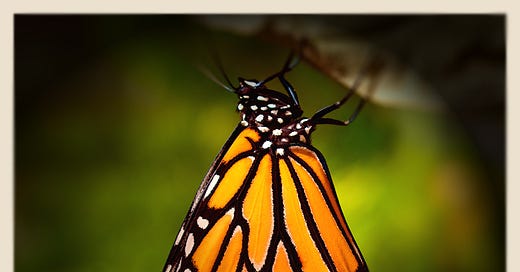With just one small milkweed plant, you can raise monarch butterflies and help save an entire species! It’s super easy, not to mention fun, and something almost everyone can do. It’s also a great project for kids and teens. If you live anywhere near the migration path of the monarch butterfly (most of the United States and Mexico), plant some milkweed in your yard (they sell it at most garden centers and nurseries), or if you live in an apartment, buy a small to medium potted milkweed plant and set it on your patio or balcony.
You don’t need a large plant for one butterfly to lay 10-20 eggs. However, it’s important to buy a milkweed species that is native to your area, as non-native milkweed plants can potentially cause problems (due to fungus) for the butterflies, resulting in butterflies that aren’t strong enough to make the full migration. There are over a hundred species of milkweed plants! Monarchs can and will use any species of milkweed as a host plant, so they're not picky, but to raise the healthiest and strongest butterflies, it's best to purchase and plant native milkweed.
The minute I got my first potted milkweed plant and put it outside, the monarchs found it and laid eggs. Also, the nice thing about a smaller potted milkweed is that as soon as you see the tiny yellow eggs on the leaves and the larvae began hatching, you can bring it inside so the wasps and other predators don’t prey upon the larvae. Put the plant somewhere out of reach and in a few weeks the caterpillars will turn into chrysalis.
There is nothing more magical what watching butterflies emerge from a chrysalis (I took the above photo right after one emerged from its chrysalis). The whole process was actually easier than I thought, because if you provide the milkweed, the monarchs will do all the rest. If you plant it they will come!
I understand that some people just don’t like bugs, and would never purposely bring caterpillars into their home. If you’re squeamish about bugs, then just plant some native milkweed in your yard and hope for the best. Another option is to leave your milkweed plant outside and cover it with a mesh laundry hamper or mesh laundry bad or some type of screen to keep the predators out. Otherwise, I suggest bringing the larvae (the caterpillars) inside once they hatch so they don’t get eaten by birds or wasps.
Indoors you will also have to contain the caterpillars once they get big because they tend to wander off when looking for a location to make their chrysalis transformation. I had them in my art studio one time (just on the plant and not contained) and I had to keep counting them and retrieving the runaways. Ultimately, I ended up with chrysalises on the bottom of my chair, on the curtain rod, on the underside of my art table and a few other odd places. Lesson learned!
Raising monarchs is much easier than you think, and it’s really fun! If you own a home you can plant a few milkweed plants in your backyard somewhere and start the process. Collectively, we could bring the monarch butterfly back from the brink of extinction! We just all need to plant a lot of milkweed, including farmers and others who control large swaths of land. I guess that’s my point here. Collectively, we have to power to make a difference. While we can’t do everything, almost all of us are in a position to do something.
Maybe there is another species in your part of the country or your part of the world that needs help. If so, there is probably something you can do, even if it’s just donating a few dollars once in a while, organizing a clean-up, or something else that isn’t a big time commitment. For me, raising monarch butterflies has been an easy, rewarding, fascinating and even magical experience. All I did was take a few cuttings from a neighbor’s giant milkweed plant, and within a week or two I was raising monarchs! A butterfly appeared out of nowhere, laid eggs, and I was in business! I really didn’t have to do much else, other than try to protect the caterpillars from being prayed upon, which I did by taking the plant inside.
There are many little projects, like planting native wildflowers, that aren’t very time consuming that can make a difference. You don’t have to do all of them, all at once, but we owe it to future generations and our planet’s other living creatures to do something. I don’t believe we’re all here on this planet just to take up space, consume mass quantities of stuff and destroy the earth in the process. I believe we are here to serve a higher purpose, and to protect this precious planet—that we’re here to do something meaningful with our lives!
#EndangeredSpecies #environment #gardening #butterflies #conservation #landscaping #pollinators #WildlifeConservation
Rebecca Pavlik is the author of Time to Break Some Rules, Sweetie! a humorous advice book for young women. For more details and to view on Amazon click here.



